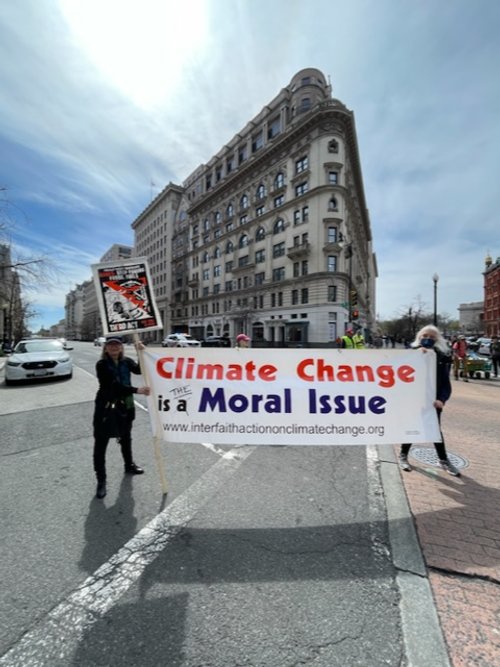Come On Out and Protest – It Makes a Difference!
by Barb Easterlin, PhD, CPA-NA Co-president
Barb Easterlin in San Francisco
Activism is any action we take to push the needle towards justice, equity, and protection of the planet and her inhabitants, especially the vulnerable, the children, and the greater than human. Using our clinical skills to influence our professional and personal circles is a huge contribution and absolutely a form of climate activism. My main form of activism is leveraging my skills as a psychologist and university professor to train, educate, and organize climate aware therapists. Many of the over 400 clinicians listed in CPA-NA’s Climate Aware Therapy directory are engaged in similar types of direct action. One very direct action is working with own feelings about climate change so that we can more easily identify and validate climate-related emotions in our consultation rooms. As a group, climate informed therapists are opening the door to conversations about grief, anger, helplessness, and other feelings of climate distress, that when explored can lead to the release of energy and creativity, and promote changes in behavior towards sustainability.
In addition to my work as a clinician and educator, I, like many of my mental health colleagues, participate regularly in on-the-street protests. Spirited and inspiring, I find street demonstrating to be invigorating and empowering. I feel strengthened by the group, not alone, and that we are making a meaningful difference.
I turn up for the large climate marches, and I have gotten out for a couple of smaller climate protests. These have been potent and personal in ways that the mass demonstrations are sometimes not. Late last summer I drove a carload of 20-something Sunrisers to the annual summer Jackson Hole Economic Symposium where Jerome Powell was the keynote (while the rest of the Sunrise group biked the 40 miles from Jackson to the symposium lodge). I got to know the five young people in my vehicle pretty well during the hour-long drive there and back again. When we arrived, there were a couple hundred demonstrators. I met some of these great people and was inspired by the speakers. One speaker from Green Latinos told a personal story of working against environmental toxins from fracking near her son’s elementary school in New Mexico. It’s one thing to read about corporations targeting BIPOC and poor communities, it’s another to hear a real person describe what happened in their own neighborhood. There is something about face to face contact that can’t be felt when we engage in other forms of support.
“We are not just the “choir” receptive to like-minded preaching when we protest, our action is actually leading to increased awareness among people in close political proximity to climate protesters.”
This past week, I met up with CPA-NA members Ariana Candell and Kathy Grayson at the Wells Fargo headquarters for a protest organized by Third Act, a climate action organization started by Bill McKibben for people over 60 who wish to support youth efforts. Both the Jackson Hole and the Wells Fargo protests were in opposition to bank funding of fossil fuel extraction and processing. People peacefully protesting, begging really, for the government to change their economic policy, and stop the banking system from lending funds for oil and coal extraction. We must keep carbon in the ground in order to survive, so it seems ludicrous for the government to work in direct contradiction to the health and well-being of its citizens. Fossil fuel extraction would not happen were it not for lending by the big 4 – Citi Bank, JP Morgan Chase, B of A, and Wells Fargo. We need to draw attention to this, so we went to the street. People waved signs, sang, did rituals, and painted the streets - to show our opinions, and to attract media attention. People were interviewed and photographed for stories.
Dr. Lise Van Susteren in D.C.
Lise Van Susteren, MD, one of CPA-NA’s Executive Committee members was at a simultaneous Third Act demonstration in Washington DC. Of her own street activism, Lise says: “I go out in the streets because that’s a good place to protest inaction on climate, because that’s a great place to put our voices together to make a loud noise… and as the late, great John Lewis said ‘to make good trouble.’”
Within the past year, with the right to choose on the line, I’ve joined in several reproductive rights demonstrations in my state of residency, Wyoming. A total ban on abortion was stayed this week, in part because people showed their opposition. My 27-year-old daughter, Emma, and my husband, Dan, have made these protests a family event – and honestly, despite the seriousness of the situation in Wyoming, I admit these are very … um… enjoyable family times as well. We urge each other on, chanting loudly and waving our signs. Also, it’s been great to meet a number of Emma’s young friends who are incredibly inviting and appreciative of our generation’s contributions.
Reproductive rights are in a tenuous place across the country, but especially in Wyoming - the first state outside of the 14 trigger ban states to try to shut down its last abortion clinic. It’s frightening and demoralizing to do nothing in an atmosphere of repression of rights. So I go to protests. It helps me feel less hopeless to be with others who share these values… to know I’m not alone.
The last few years have seen a surge in protests aiming to draw attention to racism, reproductive rights, human suffering of all kinds, retirement ages, and the Climate Crisis. And there are connections between the assaults the human rights, economic inequity, and the care of the planet. Climate action movements and activist groups like Fridays for Future have pushed the issue of climate change and environmental justice into the global spotlight. On every continent, local activists fight corporate actions that threaten to destroy precious green space and accelerate global warming. Large groups waving banners and chanting are drawing attention to issues such as greenwashing, environmental catastrophes, the financing of fossil fuel infrastructure, and unfair distribution of resources.
There are a number of reasons we should protest if we can spare the time away from family, work and other commitments. Through taking part in marching and demonstrating, we see ourselves as belonging to a wider group with a shared identity of standing up to climate destruction on behalf of future generations. It is very empowering to our identity as climate aware clinicians, to come together in solidarity with protesters, in a broader movement. For me, it is part of what keeps me motivated – knowing there are many others working in solidarity on the planet’s behalf.
Ariana Candell in San Franciso
The Yale School of Climate Communications recently published a piece asking whether such protests actually increase public support for climate action. And, if they do, which protest tactics are most effective at motivating action? Is there a backfire effect on climate deniers, making protests counterproductive? Dr. Dylan Bugden, author of the recent Socius study, analyzed this question.
To quote the YSCC review of Bugden’s study, “Bugden tests the impact of three types of climate action protests: peaceful marches, civil disobedience, and violent protests. He uses a vignette experiment design to test these effects on Democrats, Independents, and Republicans. In this experimental design, respondents answer a questionnaire about their climate beliefs before and after reading a short fictitious news story about a climate protest. The differences in their responses before and after reading the story reveal the impact of the protest on their opinions.” The results showed that climate protests do indeed shift public opinion in favor of climate action. Instead of creating a “backfire effect”, Bugden found that climate protests have absolutely no impact on Republicans, but among Democrats and Independents (i.e. independents who believe in anthropogenic causes of climate change), he found that protests increase support levels. We are not just the “choir” receptive to like-minded preaching when we protest, our action is actually leading to increased awareness among people in close political proximity to climate protesters. In this way, protests indeed do push the needle of justice in measurable ways. It should be noted that violent protests were found to have no effect on public support, but both peaceful marches and civil disobedience are effective at raising public support, with the former having the most impact.
Instead of alienating both bystanders and opponents of climate action, these tactics can be highly effective at shifting public opinion, even among previously unsupportive audiences like Independents. Using these tactics to successfully mobilize previously unsupportive audiences will be an important strategy for activists as they continue to build public and political will for climate action.
So, next time there is a climate demonstration, large or small, let’s get our voices together and get loud!
Bugden, D. (2020). Does Climate Protest Work? Partisanship, Protest, and Sentiment Pools. Socius, 6, 2378023120925949. https://doi.org/10.1177/2378023120925949




